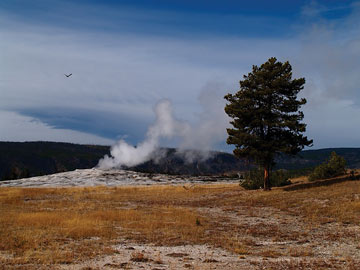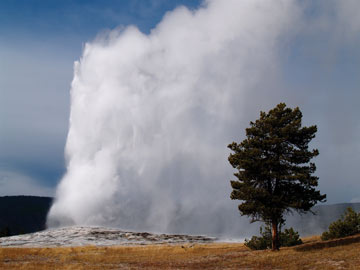|
NEWS NOTES
Predicting Old Faithful’s fidelity
 Mary Caperton Morton |
| Old Faithful is one of only a handful of the world’s 1,000 geysers that erupts regularly. |
 Mary Caperton Morton |
Old Faithful may be faithful, but it’s not always predictable. Yellowstone National Park’s famous geyser erupts more than a dozen times a day, but exactly when has long been a matter of guesstimation for park rangers and visitors. Now, a new analysis of the relationship between seasonal rainfall and geyser eruption intervals may help park rangers better estimate whether the wait between Old Faithful’s spectacular eruptions is closer to 45 minutes or two hours — an important statistic for the throngs of tourists who wait patiently to be dazzled by Yellowstone’s most popular attraction.
Old Faithful’s variable eruption schedule has been studied extensively since the geyser’s discovery in 1870. Past experiments focused on the influence of earthquakes, barometric pressure and even tides on the geyser’s periodicity. The new study, published in June in Geology, looks at how long-term precipitation trends and seasonal hydrologic cycles affect eruptions.
Geysers like Old Faithful require a special combination of three geologic factors to form: a geothermal source to heat underground water, a reservoir to hold the water while it is heating and a narrow plumbing system to pressurize and eject the plume. Once an eruption has emptied the reservoir, the chamber must refill with groundwater for the cycle to continue.
Because of the groundwater recharge factor, Shaul Hurwitz, a geologist with the U.S. Geological Survey in California, and colleagues thought that rainfall might play a role in the geyser’s periodicity. They measured the annual levels of the nearby Madison River over the past nine years and compared it with eruption data collected by instruments embedded in Old Faithful. Sure enough, the team found a strong correlation between annual wet and dry cycles and the timing, duration and height of Old Faithful’s eruptions.
The team also compared the effects of one extremely wet year in 1997 with the past eight years, which have been much drier. In years with more rainfall, they found that Old Faithful erupts more frequently at shorter intervals, but droughts could lengthen eruption intervals or stop Yellowstone’s geysers altogether. Old Faithful has erupted on 91-minute intervals lately, up from an average of 75 minutes in 1997.
Despite this decade’s drier weather, Hurwitz says that he is confident that Old Faithful will continue erupting for many years to come. “Old Faithful is huge,” he says. “It would take years of extreme drought for it to dry up.”

 Subscribe
Subscribe


